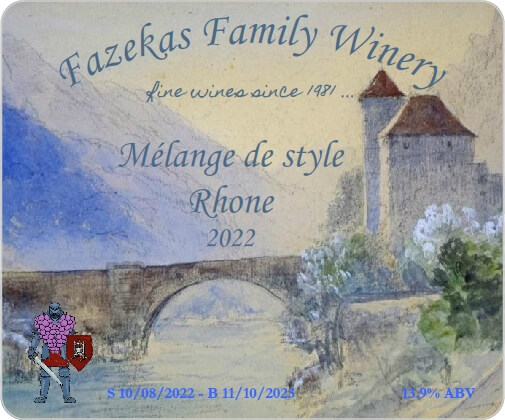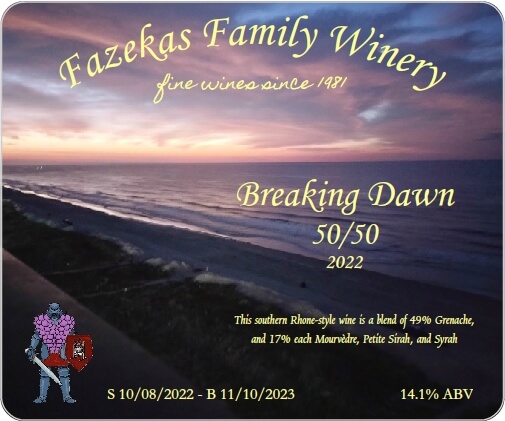2022 Grenache
updated 08/21/2025
October 2022
This fall’s main wines are a departure from the last few years. Instead of making field blends, we are making two main varietals, Grenache and Tempranillo, and a third field-blended wine (Syrah, Petite Sirah, Mourvedre) AKA 2022 Rhone Blend.
Note: “field blend” means that I select the grapes and combine them, then ferment them. This is common is some areas in Europe, e.g., whatever is in the vineyard goes into the wine. It’s more common to ferment and age the different varietals separately, then bench test (AKA tasting) to determine blends.
The Grenache and Tempranillo will be barrel aged, and the Rhone Blend will be carboy aged. Given that the barrels are long since neutral, all three wines will be aged with medium toast Hungarian oak cubes. A year from now we will selectively blend the Rhone Blend into the other two, based upon bench testing.
We made the 2022 Rhone Blend with the intention of blending it into the Grenache, which is typical of how Southern Rhone wines are blended. As with the 2022 Tempranillo, we made samples: 100% Grenache (as a baseline), and 5%, 10%, 15%, and 20% blends.
We really like the Grenache, as-is. Of the blends, we liked the 20% best, so we made additional blends, 25% and 30%. Of all the blends, we liked the 25% best.
Since we like the Grenache on its own, we bottled 3 cases, using the label that Shannon and I preferred:


For the 25% blend, we used the label Eric preferred.
Note: Each collaborative batch of wine receives 2 labels, one with my logo (grape warrior) and one with Eric’s (grapevine wrapped sword). I made the adjustments, so we have 4 total labels:


Except … when we were done, we had 3/4 gallon each of Grenache and Rhone Blend. So we just mixed ’em, producing an additional 6 bottles. I wasn’t going to put a lot of effort into a label for 6 bottles, so I re-used the Grenache label:

Ingredients
| Fruit | 8 lugs (288 lbs) Grenache |
| K-meta | 1 tsp |
| Maceration Enzyme | 3 tsp ScottZyme ColorPro enzyme |
| Nutrient | 16 tsp Fermax |
| Acid | 12 tsp tartaric acid |
| Fermentation Oak | 8 cups medium toast shredded American oak |
| Yeast | Batch #1: Lalvin RC-212 Batch #2: Renaissance Avante |
| Aging Oak | 2 oz medium toast Hungarian oak cubes |
| Glycerin | 15 oz |
Method
| Crushed grapes in two batches (4 lugs each), adding 1/2 tsp K-meta. At home each batch received 1-1/2 tsp ScottZyme ColorPro, 4 cups shredded oak, and 6 tsp tartaric acid (based on results of pH test strip).
Made 2 yeast starters with 1 cup 95 F water, 1 tsp Fermax, and 2 tsp sugar. Starter #1 received 3 packets Lalvin RC-212, while Starter #2 received 4 tsp Renaissance Avante. The starters were put in wine bottles, left on the kitchen counter for 4 hours, then moved to the cellar next to the fermenters. I didn’t bother checking SG at this point. |
10/08/2022 SG — |
| Stirred the batches and checked SG. Batch #1, which will receive Starter #1, has SG 1.094. Batch #2, which will receive Starter#2, has SG 1.100. I was surprised at the difference, but it’s not a complete surprise as different clusters will have different sugar and acid levels. I checked the SG three times in different spots in both batches, getting the same results, so I’m confident the readings are accurate.
For the purposes of my notes, I’m averaging the readings and calling it 1.097. Added the respective starters to each batch. |
10/09/2022 SG 1.097 |
| Starting today I do punch downs 3 to 4 times per day.
During the first few days I don’t bother with SG readings, as it’s a PITA. I created a jig, a 4″ diameter PVC pipe with many 1/4″ holes drilled in one end. This is wrapped in a nylon straining bag, and plunged into the must. I use a FermTech wine thief to draw wine to check SG. Since I have to sanitize everything before use, and clean grape pulp out of the bag after every use, I limit the times I check. |
10/10/2022 SG — |
| Added 2 tsp Fermax to each fermenter prior to the morning punch down. I checked SG and both were around 1.070, about 1/3 of the way through fermentation. The exact reading is not important — I just need to know roughly how far along the ferment is. | 10/11/2022 SG 1.070 |
| I got a scare this morning with the Tempranillo Batch #1– I got a whiff of H2S! While Avante doesn’t produce H2S, RC-212 can if the yeast is stressed by low nutrients. I checked the Grenache Batch #2 and didn’t detect anything, but added an additional 1 tsp Fermax as a preventative. | 10/12/2022 SG — |
| Pressed the wines, combining both batches. We cranked the basket press handle until we could not turn it, but did not use the ratchet.
The pomace was added to a Finer Wine Kits Tavola Merlot, which is detailed in 2022 Merlot Kit / Grenache Pomace. |
10/16/2022 SG 0.996 |
| While I had not intended to rack for 2 or 3 weeks, I messed up in the allocation of carboys and had to rack and redistribute as I need certain carboys for tomorrow night’s pressing of other grapes.
Racked all containers into a Brute to homogenize. Added 1 tsp K-meta, then racked into 54 liter demijohn and other containers. |
10/20/2022 SG 0.996 |
| Racked and homogenized the carboys, adding 1 tsp K-meta (20+ gallons of wine). Filled the barrel. | 11/05/2022 SG 0.996 |
| The plan is to top barrels monthly, but time got away from me, with the Christmas season. Topped with 1.5 bottles of wine.
Took a barrel sample to compare against the topup — the barrel has a slight darkening that is noticeable only when directly compared to the topup. After 6 weeks of barrel time, it also has a slight increase in perceptible tannin, palpable on the inside of the cheeks. Both are good, but the barrel is better. We discussed it, and decided to add 2 oz oak cubes. Last years’ wines had 4.5 oz each, and post bottling the oak is more pronounced. Not overpowering, but more pronounced than we like. Grenache is lighter, so we’re going lighter on oak. |
12/17/2022 SG 0.996 |
| Topped the barrel with 750 ml wine. | 01/14/2023 SG 0.996 |
| Topped the barrel with 1.5 bottles of wine. | 03/23/2023 SG 0.996 |
| Realized I haven’t added K-meta recently, so added 3/4 tsp to the barrel, and 1/4 tsp to the carboy. Made solution of 6 Tbsp water with 1/4 tsp K-meta, and added 1 Tbsp to each 4 liter jug. | 04/07/2023 SG 0.996 |
| Topped the barrel with 750 ml wine. I goofed, adding 375 ml Grenache and 375 ml Tempranillo, but in the grand scheme of things, not a big deal. | 04/23/2023 SG 0.996 |
| Topped the barrel with a bit over 750 ml of the Rhone blend. I realized the only Grenache topup I have is in 19 liter carboy, and I did not feel like subdividing that into smaller containers. Since I’m going to top with the 2022 Rhone blend anyway, I used some of that. | 06/17/2023 SG 0.996 |
| Topped with 750 ml of the Rhone blend. Added 3/4 tsp K-meta to the barrel. | 07/19/2023 SG 0.996 |
| Topped with 750 ml Rhone blend. | 08/23/2023 SG 0.996 |
| Topped with 1.5 liters Rhone bend. | 09/27/2023 SG 0.996 |
| Topped with 750 ml Rhone bend. | 10/26/2023 SG 0.996 |
| Bottled, adding 1 tsp K-meta and 15 oz glycerin. From taste testing we elected to bottle 3 cases as a straight Grenache, and and the remaining 6.5 cases as a 75/25 blend with the 2022 Rhone Blend.
At the end, there was 3/4 gallon of each wine leftover, so bottled 6 bottles of a 50/50 blend. This produced a larger number of bottles than the amount of Grenache suggests. |
11/10/2023 SG 0.996 |
Notes
| Yield | 36 bottles Grenache 78 bottles Grenache 75% / Rhone Blend 25% 6 bottles Grenache 50% / Rhone Blend 50% |
| Alcohol | 13.7% Grenache 13.9% Grenache 75% / Rhone Blend 25% 14.1% Grenache 50% / Rhone Blend 50% |
| 06/24/2025 | FYI – the 50/50 blend is long since gone. The Rhone Blend overpowered the Grenache and not good in its own right. I used it mostly for cooking.
The Melange de style Rhone (75/25 blend)? This is among the best wines I’ve ever made. I’m happy to have a LOT of this one! Unaerated: This is good, as is. Tannin is well balanced, although predominant. Aerated: As expected, the aeration softens the tannins, bringing out the fruit, which is a mixture of strawberry with dark fruit. It’s an interesting mixture of flavors. The wine is more harmonious in expressing all the numerous flavors. Yet in the aftertaste, the tannin lingers on the sides of the tongue, so it’s delicious long after swallowed. |
| 08/21/2025 | I’ve been avoiding the “pure” Grenache as I only had 1 case of it. But today, as it approaches 3 years of age, it called to me.
Important note: after bottling, I calculated that by using the Rhone Blend to top the Grenache barrel, the Grenache is actually 4% Rhone Blend, which explains the darker color. Unaerated: Nose is muted. Taste has some strawberry, but there’s harsh tannin overshadowing it. Aerated: As is typical, aeration completely changed the wine. The aroma is stronger, but hard to define. I’ve not had a straight Grenache before, but I suspect that’s what I’m smelling. The strawberry flavor of the Grenache stands out, with a lingering tannin / leather aftertaste from the bit of Rhone Blend. As much as I’d like to compare this wine (96% Grenache / 4% Blend) against 100% Grenache, I expect this one would win due to the higher complexity. |
| . | . |
| . | . |
